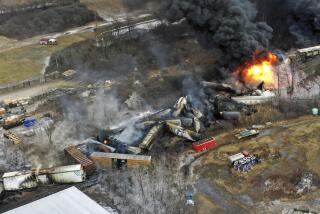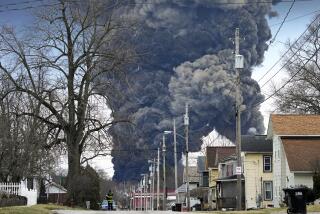Runaway Freight Train Is Finally Halted
- Share via
CHICAGO — Pursued by dozens of emergency vehicles, a driverless, runaway freight train loaded with thousands of gallons of hazardous chemicals steamed through 66 miles of northwestern Ohio on Tuesday before another locomotive was able to slow the train and a railroad employee leaped aboard and slammed on the brakes.
Railroad officials initially believed the engineer had collapsed at the controls, and ambulances joined police and hazardous-materials crews for the train’s two-hour ghost run from Stanley, southeast of Toledo, to Kenton.
In fact, the engineer was back at the CSX Corp. switching station in Stanley, where officials believe he had climbed down from the black-and-yellow locomotive to flip a switch when the train rolled away.
The engine and its braking systems, designed to prevent such runaways, as well as the actions of the engineer, are the focus of an investigation by the Federal Railroad Administration and the company.
Twenty-five of the train’s 47 cars were empty when it began chugging south about 12:30 p.m. EDT, company officials said. Twenty of them were loaded with paper, lumber and other nontoxic freight.
The last two cars in the line, however, were full of molten phenol, an industrial chemical used in the manufacturing of paints and dyes and as a disinfectant.
The chemical is rated as moderately flammable but highly toxic, and potentially fatal if inhaled, ingested or even absorbed through skin contact, according to the Occupational Safety and Health Administration. County emergency officials all along the route watched nervously as the train passed, at times within 50 feet of homes, factories and businesses.
Only one area was evacuated, however, a meat processing plant near the village of North Baltimore. In most cases, emergency workers simply didn’t have time to act.
“All we could do is sit here and watch, wait and hope,” said Bill Day, the emergency management director for Hancock County, just minutes after the train passed through about 1:30 p.m.
The drama began in a busy switching yard as the engineer, whom the company declined to identify, finished preparations for a run literally across the street. The plan, company officials said, was to tote the cars over to an adjacent Norfolk Southern switching yard and drop them off.
When the engineer stepped away, the locomotive began to roll.
The engineer sprinted to tell yard supervisors, who immediately began calling area law enforcement agencies. But the train accelerated to as fast as 46 mph, according to a state trooper’s radar gun, as it entered Wood County just a few miles down the line.
One of the first places they called was Bowling Green, the largest city in the county and the site of a sharp turn in the tracks.
At 12:38 p.m., according to Wood County Sheriff’s Department logs, CSX phoned and warned them the train was barreling their way and might well derail at the bend. Four minutes later, it was at the city limits, said Deputy Rose Chambers.
The Sheriff’s Department called out all fire and emergency units, and deputies raced to block off railroad crossing points near the bend.
The train raced through the turn, stayed upright and continued to plow southward.
CSX officials decided it was time to derail the train on purpose. Twenty-three miles down the line, they set what is called a mobile derailer. Their hope was to knock only the first few cars off the tracks, which would stop the train but spare the cars with hazardous materials any damage.
But the train was moving too fast. It blasted right through the derailer and kept going.
The train had now been on the loose nearly an hour, and news helicopters clattered overhead as emergency vehicles stacked up along the nearby roadways. CSX officials came up with another plan.
Twenty-eight miles down the line sat another CSX train. Officials radioed engineers Jesse Knowlton and Terry Forson.
“We unhooked their locomotive and said, ‘Go catch that train,’ ” CSX spokesman Dan Murphy said.
When the runaway train sped by, Kowlton and Forson gave chase, soon closing in and attaching their locomotive to the last car. Then they hit the brakes.
With the first engine still pulling, however, the two were unable to stop the train completely. After 10 miles, though, near the town of Kenton, they had slowed it to less than 10 mph.
Jon Hosfeld, a 31-year veteran of the railroads, stood by the tracks. As the train approached, he sprinted alongside, leaped onto the locomotive and quickly ducked inside. He shut the engine down and hit the brakes. A quarter of a mile down the track, the train ground to a halt.
Times staff writer Megan Garvey in Washington and researcher John Beckham in Chicago contributed to this story. Video of the runaway CSX train being brought to a stop is on The Times’ Web site: https://https://fold6.site/train
More to Read
Sign up for Essential California
The most important California stories and recommendations in your inbox every morning.
You may occasionally receive promotional content from the Los Angeles Times.










